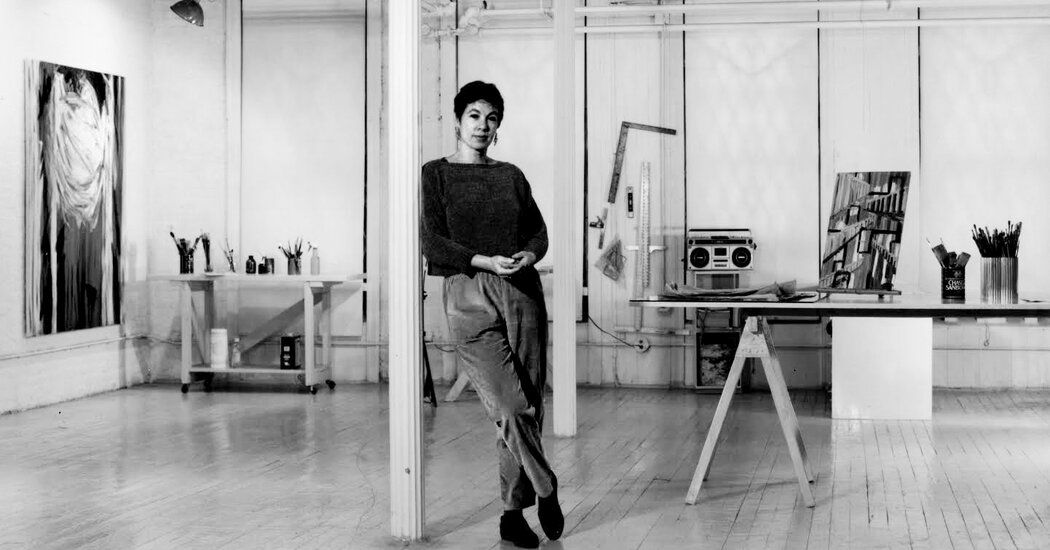Martha Diamond, a painter who captured the ever-changing face of New York’s buildings, streets and light-filled vistas with deceptively simple expanses of color, died Saturday after a long illness. She was 79 years old.
His death was confirmed by the Martha Diamond Trust.
Ms. Diamond’s work occupied a unique point at the intersection of several approaches. She handled the paint with the gestural enthusiasm of a material-focused abstract expressionist. His austere but vibrant depictions of his hometown, in which an eight- or ten-story building on a busy street might be reduced to a liquid gray rectangle against an undifferentiated orange sky, recalled mid-period Mondrian, before the pioneering Dutch abandoned it completely. representative painting.
To avoid doing anything from memory, he painted with his non-dominant left hand. And in her deep engagement with the details of her own environment (she often painted the view from her light-filled loft on the Bowery), she was like Jane Freilicher and other mentors and friends of the New York School.
Personally, she was also a point of intersection, maintaining long-standing friendships with poets, gallery owners, and painters; teach generations of students; and maintaining her small but fundamental place in the development of American painting with unwavering devotion.
But if his artistic life was characterized by the proliferation of influences and interests, his art itself was largely defined by what it excluded.
In his 1988 painting “World Trade,” one of three works included in the 1989 Whitney Museum of American Art Biennial, two thick, soot-covered bars hang in the middle of a six-foot-high canvas. Its color, which ranges between brown and pink, is denser on the upper and lower edges. The distinctive wood grain-like texture of long, visible brush strokes both captures the buildings’ famous vertical lines and, by exposing slivers of unpainted white linen, suggests a dazzling glow. And other than a few blurry red and blue lines behind the buildings and some diagonal strokes in front that could be clouds, that’s it.
“People who look at the painting have an idea of what the World Trade Center is, and here is a painting called ‘World Trade Center,’” Ms. Diamond explained in a video interview published by Magenta Plains Gallery, which briefly represented. “The interesting thing is how much is left out when you know exactly what it is.”
What she left out, paradoxically, made what was left inexpressibly richer. Viewers were able to immediately grasp the essence of the topic without getting lost in superfluous details.
“Recognition or familiarity leads the viewer to look for the expected details,” he told poet Bill Berkson in a 1990 Artforum article. “For the most part, the details are not there, so you look more at the painting and the picture. You begin to distinguish between painting, performance, image, idea, expectation and you.”
Martha Bonnie Diamond was born on May 1, 1944 in Manhattan, the daughter of Norman Diamond, an internist, and Lillian (Levine) Diamond, a homemaker. She grew up in Hollis Hills, Queens and in Stuyvesant Town in Manhattan. She is survived by her sisters, Miriam Diamond-Barber and Elaine Diamond Ford, and a brother, Michael Diamond.
Ms. Diamond began drawing as a child and often accompanied her father on hospital visits near the Central Park Conservatory Garden, being amazed, many decades later, by the imposing Manhattan skyline that appeared as they crossed the Manhattan Bridge. Queensboro.
She earned a bachelor’s degree in art and art history from Carleton College in Northfield, Minnesota, in 1964. There she became friends with artist Donna Dennis and poet and art critic Peter Schjeldahl.
After a graduate trip to Paris with Ms. Dennis, Ms. Diamond returned to New York, where she went to the movies with poet Ted Berrigan, spent time with poet Ron Padgett, and explored the city’s neighborhoods with Mr. Schjeldahl.
Poet Anne Waldman, another friend, recalled the “passion of becoming artists together.”
“When you feel it with people who already have this conviction,” he said in an interview, “it’s very present in them, and I felt it with Peter at a young age, and with Donna and Martha.”
In 1966, Ms. Diamond took a job in the film department of the Museum of Modern Art. “I learned a lot working there, helping at different inaugurations,” she told Artforum in 2021. “I ate in the gardens and a poet brought drugs, and that was cool.”
Ms. Diamond found her loft on the Bowery, below Houston Street, in 1969 and remained there for the rest of her life. In 1970, the painter Joan Mitchell visited her there and encouraged her to move the paintings of her, which she had been painting on the floor, to a wall of hers.
In the years that followed, Ms. Diamond led printmaking workshops in New York City public schools as part of the Solomon R. Guggenheim Museum’s Learning Through Art program and taught at Harvard, Yale, the Goddard Riverside Community Center in New York and the Skowhegan School. of Painting and Sculpture in Madison, Maine, on whose board of directors she also served for 36 years.
His first solo exhibition was at the Brooke Alexander Gallery in 1976, and it was there, in 1982, that he premiered his urban landscape paintings. She later joined the Robert Miller Gallery.
Ms. Diamond had successes, appearing in the Whitney’s influential “MetaManhattan” exhibition in 1984 as well as its 1989 Biennial, winning a National Endowment for the Arts fellowship in 1980 and an Academy Award for Art from the Academy. American Academy of Arts and Letters in 2001. His work has been acquired by the Art Institute of Chicago, the Brooklyn Museum, the Whitney, the Museum of Modern Art, the Guggenheim, and others.
But his recognition was never entirely proportional to the importance of his work.
“There was that kind of early experience of not feeling the same interest in our work as the male artists in the circle,” Dennis said in an interview. “In her later years she was getting her fair share of attention, but her work could have gotten it sooner. She was just as strong 30 or 40 years ago.”
The David Kordansky Gallery, which recently began representing Ms. Diamond, will present her work in a solo exhibition in Los Angeles this spring. A traveling exhibition is also planned for 2024, to be presented at the Colby College Museum of Art in Maine and the Aldrich Museum of Contemporary Art in Connecticut. And she has been championed by prominent painters such as Alex Katz, who said her work “represents the spirit of optimism of the 1960s,” and David Salle, who curated her work in group exhibitions at Skarstedt Gallery and the Hill Art Foundation. both in New York.
“Martha Diamond was a wonderful painter who did not fit with the fashion of the time,” Salle said in a statement. “She didn’t seem to have a big ego, so people felt justified in thinking she was lesser. His abandonment didn’t make her happy, but it didn’t stop her either. Her posthumous fame will now be hers. I hope she enjoys it.”












